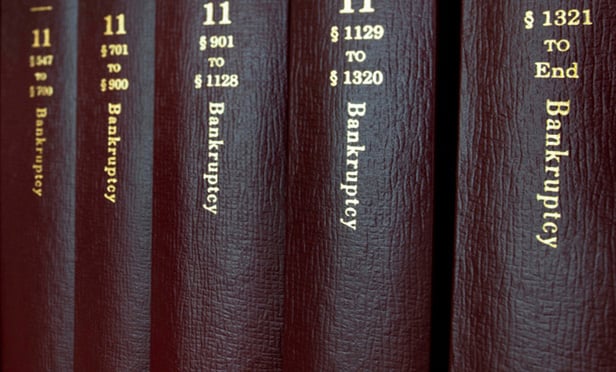Features

Top Bankruptcy Partners Rates Are Climbing
The trend of above-average rate increases began during the pandemic.
Features

Three Things Trustees Should Know About Due Diligence in Preference Litigation
Courts have struggled with the interpretation of the 2019 amendment to Section 547, specifically whether the due diligence requirement is an element of a preference claim that must be adequately pleaded in the plaintiff's complaint. While the law is still developing, there are three important takeaways for trustees to consider.
Features

Split Second Circuit Narrows Bankruptcy Code's Settlement Payment Safe Harbor
The majority was sensibly concerned with the possible structuring of leveraged buyouts by artful counsel who would use a financial institution as a "mere conduit" to exploit the Code's safe harbor.
Features

Distressed Real Estate Bankruptcies Continue, Despite Interest Rate Peak
Although interest rates may have peaked, we continue to expect a large volume of distressed real estate debtors to utilize the bankruptcy system over the next couple of years. This article analyzes two recent decisions regarding distressed real estate bankruptcies, both of which involve rights of real estate lenders against proceeds of collateral other than the real estate itself.
Features

To What Extent Does a Bankruptcy Court Have Jurisdiction Over a Post-Confirmation Lawsuit?
In the recent decision of Tew v. ED&F Man Capital Markets, the U.S. Bankruptcy Court for the Eastern District of Kentucky addressed a thorny decision for all bankruptcy courts, namely to what extent a bankruptcy court has jurisdiction over a post-confirmation lawsuit.
Features

Following Uptick In 2023, Bankruptcy Lawyers Are Expecting a Busy 2024
Predictions of an uptick in bankruptcy filings came true this year, and bankruptcy lawyers are expecting a steady continuation into 2024, with the use of alternative approaches continuing to increase.
Features

The Bankruptcy Strategist Is Going Digital Only. Here's What You Need to Know.
The final print edition of The Bankruptcy Strategist will be our January issue.
Features

Litigation Finance Offers Significant Benefits for Restructuring Matters
In today's volatile economic climate, companies need to be more creative to find ways to mitigate risk. Litigation finance is one of those out-of-the-box solutions that can provide benefits.
Features

Key Win Likely for Commercial Shopping Center Lessor In Second Circuit
The Second Circuit, on remand from the U.S. Supreme Court, further remanded to the district court the key issue of whether the Chapter 11 debtor gave "adequate assurance of future performance of" a commercial real property shopping center lease "as required by [Bankruptcy Code] §365(b)(3)(A)," after the debtor's assignment of its lease.
Features

CA Bankruptcy Court Throws Regulatory Concerns Aside and Sides With Cannabis Business' Chapter 11 Plan
While this case does not fully open the courthouse doors to cannabis-related businesses and seemingly grants the bankruptcy courts a great deal of discretion when ruling on similar cases in the future, cannabis-related businesses may now have a roadmap to pursue reorganization.
Need Help?
- Prefer an IP authenticated environment? Request a transition or call 800-756-8993.
- Need other assistance? email Customer Service or call 1-877-256-2472.
MOST POPULAR STORIES
- The 'Sophisticated Insured' DefenseA majority of courts consider the <i>contra proferentem</i> doctrine to be a pillar of insurance law. The doctrine requires ambiguous terms in an insurance policy to be construed against the insurer and in favor of coverage for the insured. A prominent rationale behind the doctrine is that insurance policies are usually standard-form contracts drafted entirely by insurers.Read More ›
- A Lawyer's System for Active ReadingActive reading comprises many daily tasks lawyers engage in, including highlighting, annotating, note taking, comparing and searching texts. It demands more than flipping or turning pages.Read More ›
- The Brave New World of Cybersecurity Due Diligence in Mergers and Acquisitions: Pitfalls and OpportunitiesLike poorly-behaved school children, new technologies and intellectual property (IP) are increasingly disrupting the M&A establishment. Cybersecurity has become the latest disruptive newcomer to the M&A party.Read More ›
- Abandoned and Unused Cables: A Hidden Liability Under the 2002 National Electric CodeIn an effort to minimize the release of toxic gasses from cables in the event of fire, the 2002 version of the National Electric Code ("NEC"), promulgated by the National Fire Protection Association, sets forth new guidelines requiring that abandoned cables must be removed from buildings unless they are located in metal raceways or tagged "For Future Use." While the NEC is not, in itself, binding law, most jurisdictions in the United States adopt the NEC by reference in their state or local building and fire codes. Thus, noncompliance with the recent NEC guidelines will likely mean that a building is in violation of a building or fire code. If so, the building owner may also be in breach of agreements with tenants and lenders and may be jeopardizing its fire insurance coverage. Even in jurisdictions where the 2002 NEC has not been adopted, it may be argued that the guidelines represent the standard of reasonable care and could result in tort liability for the landlord if toxic gasses from abandoned cables are emitted in a fire. With these potential liabilities in mind, this article discusses: 1) how to address the abandoned wires and cables currently located within the risers, ceilings and other areas of properties, and 2) additional considerations in the placement and removal of telecommunications cables going forward.Read More ›
- Guidance on Distributions As 'Disbursements' and U.S. Trustee FeesIn a recent case from the Bankruptcy Court for the District of Delaware, In re Paragon Offshore PLC, the bankruptcy court provided guidance on whether a post-plan effective date litigation trust's distributions constituted disbursements subject to the U.S. Trustee fee "tax."Read More ›
